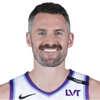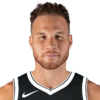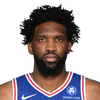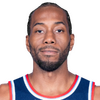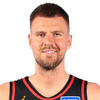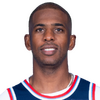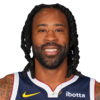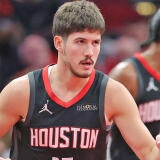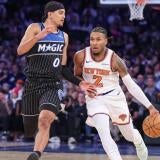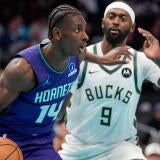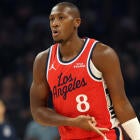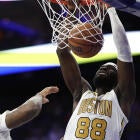2019-20 Fantasy Basketball: Potential busts for 2019-20
Whether it's age, injury or role, there are tons of key players who could be in position to disappoint Fantasy managers.
Every Fantasy owner wants to find the next great sleeper, but avoiding potential busts is just as important. When seeking out players to avoid there are three categories in which most can be placed: Age-related decline, injury risks and role uncertainty.
The more boxes a guy checks, the riskier a pick they are for your Fantasy team. That doesn't necessarily mean you should avoid them entirely -- almost all players are worth drafting if they fall far enough -- but it's important to exercise caution when considering the following players.
Age concerns
Gasol is making an appearance on my list for a second consecutive season. He was relatively close to proving me wrong in 2018-19, as he averaged 15.7 points, 8.6 rebounds, 4.7 assists and a combined 2.3 blocks/steals with the Grizzlies. But then he was dealt to the Raptors, who decided it was not, in fact, necessary to play a 34-year-old center nearly 34 minutes per night. Gasol actually played 43 minutes in his third-to-last game with the Grizzlies. The team was 20-31. They lost. Gasol went 6-for-16 from the field.
Toronto proceeded to deploy him for an appropriate 24.9 minutes per game, and he averaged 9.1 points, 6.6 rebounds and 3.9 assists. The post-Kawhi Raptors' direction this season is somewhat unclear, but it's unlikely they'll lean on Gasol as much as Memphis did. And while Gasol has been durable over the past three seasons, only 11 centers in NBA history over 34 years old have played at least 70 games and seen more than 24 minutes per night -- none of those came within the past 10 years. We can't throw away the possibility that Gasol joins that company, but the combination of age and a declining role makes him a less-than-ideal draft target.
Aldridge deserves credit for making the All-Star Game each of the past two seasons in a loaded Western Conference. Over that span, he's averaged 22.2 points on 51.4 percent shooting, 8.8 rebounds, 2.2 assists and 1.3 blocks. But since the beginning of the three-point era, only three players age 34 or older have averaged at least 20 points and eight rebounds while shooting at least 50 percent from the field: Karl Malone, Kareem Abdul-Jabbar and Hakeem Olajuwon.
Aldridge will continue playing a key role in the Spurs' offense, and he's been relatively durable throughout his career. But keeping up the numbers he's been producing lately would be historic at his age. We shouldn't be surprised if he finally takes a tangible step back in 2019-20.
Has a player ever gotten better every single year of his career leading up to his age 35 season? That's what Redick has managed to do, as he set career-highs in points (18.1), 3s (3.2) and free-throws (3.0) last season. It feels wrong to put him on this list, but hear me out.
How long can this go on? Redick has an advantage in that his game is predicated on deadly 3-point shooting, rather than athleticism. But he's still runs around more screens than nearly anyone in the league, and he's already been a significant defensive liability for much of his career. From a role perspective, he'll have less security in New Orleans than they had in Philly. Even though Redick was a top target in free agency, the Pelicans have a plethora of backcourt options, and if the playoffs become out of reach, Redick could see his minutes start to dwindle as the organization prioritizes young players.
While it's reasonable for Fantasy owners to expect Redick to average around 15 points and 2.5 3s per game, doing so would make him the first 35-year-old in NBA history to accomplish the feat. Would I be shocked if Redick makes history in that respect? Not necessarily. Do I want to bank on it? No.
Millsap's bust potential is rooted in a triple-threat of age, injury concerns and the likelihood of a reduced role.
About to enter his age-34 season, Millsap has seen his workload decline each of the past two years. It fell to 27.1 minutes per game in 2018-19, which was his lowest mark since his second NBA season. He's also struggled to stay healthy, playing an average of 59.0 games over the past three campaigns.
Denver also heads into 2019-20 with arguably the deepest overall roster in the league. That depth was shored up by the addition of Jerami Grant, who poses a major threat to Millsap's workload. Michael Porter Jr., provided he develops into a rotation player, could also eat into Millsap's time at power forward. Given the presence of Mason Plumlee, the veteran doesn't really have the option to move to backup center, either.
All things considered, Millsap should still be a productive per-minute player, but the Nuggets won't need him to be more than a glorified role player. While he shouldn't be avoided altogether, Millsap's name recognition will likely result in him being overdrafted.
Injury liabilities
Love is still one of the league's best big men when healthy, and he's averaging 17.1 points, 10.0 rebounds, 2.2 3s and 2.1 assists as a member of the Cavaliers. But since 2012-13, Love is averaging just 55.4 games per season, and he hasn't played more than 60 games in any of the past three campaigns.
Plus, with Cleveland in a full rebuild, there is little incentive for Love to be brought back quickly from any minor injury. What's the point of playing Love on a sprained ankle when the Cavs are 4-17 and can get Larry Nance, Cedi Osman and Ante Zizic some extra run? While Love only needs around 60 games to return top-60 value, drafting him with grand expectations could, once again, lead to disappointment.
Appearing in 75 contests last season, Griffin crossed the 70-game threshold for the first time since 2013-14. The big man was able to secure his fifth All-NBA selection in the process, showing his versatile skill-set with averages of 24.5 points, 7.5 rebounds and 5.4 assists. That resulted in Griffin returning 3rd-round value.
But considering he's averaging only 59.2 games over the past five years, the numbers suggest Griffin once again reaching 70 games played is highly unlikely. Keep in mind that while he had his healthiest campaign in years, Griffin's body still broke down at the end of last season, and he was able to appear in just two of the Pistons' four playoff games. As a result, Detroit will likely be more cautious this time around, but as Griffin enters his age-30 season, there's little reason to believe he'll ever be able to shake his injury-prone label.
There are probably as many Fantasy owners who are optimists when it comes to Cousins as there are pessimists. But all it takes is one optimist in a Fantasy draft to inflate his ADP. When that's the case, a player's chances of busting can increase dramatically.
Cousins is a prime example. Last season, he returned from a torn Achilles -- one of the most devastating injuries an athlete can suffer -- to play 25.7 minutes across 30 regular-season games for one of the best teams of all time. But he ended up suffering a non-contact quad injury during the first round of the playoffs and not returning until the Finals.
His performances against Toronto ranged from pretty good to virtually-unplayable, though Cousins was playing at well below 100 percent. Given the team context and relatively small sample last season, it's still unclear just what this post-injury version of Cousins will look like going forward.
With that in mind, what should be considered a successful season for Cousins in Los Angeles? Around 65 games, 26 minutes per game, and averages of 16 points, eight rebounds, three assists and a block? That would be close to what Marc Gasol averaged last season, which translated to mid-third-round value. Based on some (very) early drafts, that's the range in which Cousins will come off the board. A few more months of rest and rehab will only help Cousins return to form, but that's a pretty high price to pay given his injury history and the Lakers' other options at center.
It feels like a distant past, but Embiid missed the first two seasons of his NBA career due to injury, and then proceeded to play in just 31 games during his rookie season. He's been excellent across the past two campaigns, staying just healthy enough (63 and 64 games) to make the All-NBA team both seasons.
If Philly wasn't among the most talented teams in the league and needed Embiid to perennially play 70-plus games to make the playoffs, he probably could. But there's no reason for this iteration of the Sixers to run Embiid into the ground -- especially in a still-inferior Eastern Conference. They'll be able to win games when he sits -- especially with another highly capable big man on the roster in Al Horford.
Fantasy owners shouldn't expect Embiid to play more than 65 games, but he'll probably still be drafted in the first round based on talent alone. It's important to consider that he finished as the 30th overall Fantasy player in 2017-18 and the 13th overall player last year. As long as he avoids a major injury, Embiid won't be anything close to a true "bust." But pulling the trigger too early could mean missing out on a more cost-effective target. The middle of the second round is a more appropriate place to draft Embiid, based on the risk factors at play.
Last season, Leonard not-so-quietly reminded us that he's the best two-way player in the world. At the same time, he's a great example of a player who is better in real life than in Fantasy. Leonard's best Fantasy finish is eighth overall, which clearly does not align with the value he provides in real-life.
Leonard finished 21st overall last season, despite playing in only 60 games for the Raptors with averages of 26.6 points, 7.3 rebounds, 3.3 assists and 1.8 steals in 34.0 minutes. Toronto let him rest as needed, and chances are, the Clippers will allow him to do the same.
While most expect Leonard to play more than 60 games, with a best-case scenario of around 70, he's still just two years removed from the significant quad injury that caused him to miss almost the entire the 2017-18 season. It was still an issue last season all the way through Game 6 of the Finals. If it wasn't, there would be no load management discussion. Leonard will likely be a late-first-round pick in almost every draft, but that's about his ceiling from a value perspective.
Porzingis is coming off a torn ACL suffered in 2017-18 that caused him to miss all of last season. Leading up to the 2015 Draft, scouts were worried about Porzingis' 7-foot-3, 240-pound frame holding up. He still went fourth overall, but the injury concerns have come to fruition.
Porzingis' first four seasons in the league: 72 games, 66 games, 48 games, zero games.
His talent is undeniable. Porzingis finished as a top-55 player during his first two years in the league, despite the missed games, and he was ranked 22nd overall on a per-game basis in 2017-18. But Dallas is committed to the long game with the Porzingis-Doncic duo, and it wouldn't be surprising if the former was rested on occasion to protect his longevity. On top of that concern, Porzingis carries the inherent risk of any player switching teams. While he should fit seamlessly into the Mavs' frontcourt, it'll take time for him to carve out his niche on a much more talented roster than he was used to in New York.
Paul is entering his age-34 season and is coming off one of the least-productive years of his career, even putting aside his games missed. Averaging 15.6 points, 8.2 assists, 4.6 rebounds and 2.0 steals while shooting 41.9 percent, Paul finished as the 18th-ranked Fantasy player on a per-game basis. While that's clearly very good, it's his second-lowest finish ever after he was a top-10 player from 2007-08 through 2016-17.
Plus, Paul has played between 58 and 61 games each of the past three seasons. In terms of total production, that's resulted in him finishing as the 24th-best player in 2016-17, the 28th-best in 2017-18, and 48th-best last season. He's trending downward, and quickly.
Playing for the Thunder and away from one of the highest-usage players ever will probably afford Paul more opportunities to work with the ball in his hands. Maybe Paul can bounce back in terms of per-game production -- the table is set for that to happen. But the missed games are increasingly worrisome. Paul simply hasn't proven he can stay healthy, even when the Rockets made a concerted effort to reduce his nightly workload. The future-Hall-of-Famer will open a new chapter in Oklahoma City, but it's likely to be a familiar story for Fantasy owners.
Uncertain roles
Russell joining the Warriors without Kevin Durant and Klay Thompson (for most of the year) is just a flat-out strange situation. Coming off the best year of his career, when he was the driving force for the breakout Nets, the 23-year-old Russell will now join a team with established playmakers in Steph Curry and Draymond Green.
Opinions on Russell's upside with Golden State vary. His age suggets he'll continue developing, but what are the odds he finishes with a better season than last year, when he ranked as the 19th-best Fantasy player?
The gut reaction for most is to assume that's impossible. But it's worth considering that until Thompson returns, Alec Burks might be a top-six player for the Warriors. In no way is that an exaggeration. Curry, Russell, Green and Willie Cauley Stein (?) will have to carry the offense for extended periods, and even including Green and Cauley-Stein on that list may be a stretch. Playing alongside by far the best teammate of his career means Russell's usage should decline, but by how much?
Despite the progress Allen has made early on in his career, the Nets added DeAndre Jordan in free agency. The motivations behind that decision differ based on who you ask, but either way, Brooklyn has a dicey situation on its hands. Jordan has been a no-question starter for the bulk of his career, but will the Nets' risk stunting Allen's growth to appease a 31-year-old?
Even if Allen is able to hold off the veteran, Jordan is going to be a major part of the rotation -- and neither player has experience at anywhere but the center position. The most likely scenario is a relatively even timeshare. That would keep both players Fantasy-relevant, but it's nonetheless frustrating, given what Allen, still just 21 years old, could provide in a 30-plus-minute-per-night role.
In addition to questions about his potential, Ball's durability can be called into question, as the former No. 2 overall pick has appeared in just 99 games through his first two seasons. But we almost have to assume that will improve. If it doesn't, serious questions will begin to emerge about whether Ball can sustain the physical toll of NBA basketball.
From a role perspective, Ball has had a difficult start to his NBA career, to say the least. During his rookie season, he was tasked with running the show for a tanking team. Last season, Ball was asked to function as the starting point guard but also get out of the way whenever LeBron James felt like taking over. Historically, neither of those situations are conducive to success.
Ball is getting a fresh start in 2019-20 after being traded to the Pelicans. He projects to start next to Jrue Holiday in the backcourt, though there is the possibility coach Alvin Gentry decides to start J.J. Redick over Ball, with Holiday at the one. Regardless, Ball should see minutes in the upper-20s or low-30s. He has clear upside as a multi-category contributor, and Ball actually finished top-60 during his rookie year on a per-game basis by averaging 10.2 points, 7.2 assists, 6.9 rebounds and a combined 2.5 steals/blocks.
The main concern for Ball is his shooting, which has been ... rough. Despite unorthodox form, Ball went 80-of-194 (41.2%) from distance during his lone season at UCLA, though his 66-of-98 (67.3%) mark from the charity stripe raised some red flags. In the NBA, his career shooting splits sit at -- please shield your children's eyes -- 38.0 percent from the field, 31.5 percent from 3 and 43.7 percent on free-throws. Just as concerning as shooting 43.7 percent on freebies is the fact that Ball has attempted just 119 free-throws in his career. For context, James Harden averaged 119 free-throws every 10.8 games last season. Ball has some obvious holes in his game to fill, and drafting him too early could be a Fantasy pitfall -- especially now that he's on a team with other options.
Williamson appeared only briefly in summer league before being shut down due to a minor knee injury. His physical gifts are clearly as-advertised, and he looks like he'll be dominant around the basket. On the other hand, Williamson's jumpshot looked like a work in progress, and he's not much of a ball-handler in the halfcourt. Williamson has to work on his wing skills before becoming a high-usage player, though his upside as a slasher and straight-line driver are very clear.
It's difficult to imagine Williamson struggling on the glass or as a shot-blocker, but opposing defenses will dare him to shoot and make plays on his own. Fouling him on the way to the basket is an option, as well, and Fantasy owners need to take into account that Williamson shot just 130-of-203 (64.0%) from the charity stripe in college.
He'll benefit greatly from NBA spacing, and there's only so much we can knock his scoring potential given that he dropped 22.6 points per game on 68.0 percent shooting at Duke. But it's not a given that he'll be an elite scorer out of the gates on a roster with plenty of proven NBA talents.
Grant took on an expanded role last season as the Thunder's starting power forward. He appeared in 80 games and averaged 13.6 points on 49.7 percent shooting, 5.2 rebounds, 1.4 3s, 1.0 assist and a combined 2.1 blocks/steals. Ultimately, his efficiency and shot-blocking ability helped him return sixth-round value to Fantasy owners.
But OKC traded Grant to the Nuggets in the offseason, and looking at the roster, it's hard to envision the Syracuse product not taking on a lesser role. While Grant has shown some ability to play small forward and center in the past, power forward is his primary spot. The Nuggets brought back Paul Millsap -- at a $20 million price tag -- to fill the position, and while Millsap's best days are behind him, he'll still be a significant part of the rotation. While Grant could push for a starting spot as the season progresses, he's unlikely to come close to matching the nearly 33 minutes per game he averaged in Oklahoma City last season.
Richardson ran the Heat's offense for much of 2018-19, pacing the team in total points (1,209) while also ranking second in assists (298) and first in steals (79). However, his field-goal percentage (41.2%) suffered from the increased usage. Still, he was able to return sixth-round value in most Fantasy leagues.
In being dealt to the 76ers, Richardson could see his usage -- career-high 20.9% USG last season -- reduced rather drastically. He'll presumably be the fourth or fifth option on the first unit, and while his efficiency should trend in the right direction, his scoring and assists production is likely to take a step back. Given what Richardson provides in steals, blocks and 3s at his position, he'll remain a valuable Fantasy asset. But he's a player who'll be prone to over-drafting based on last year's numbers.








